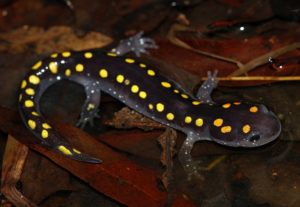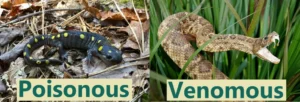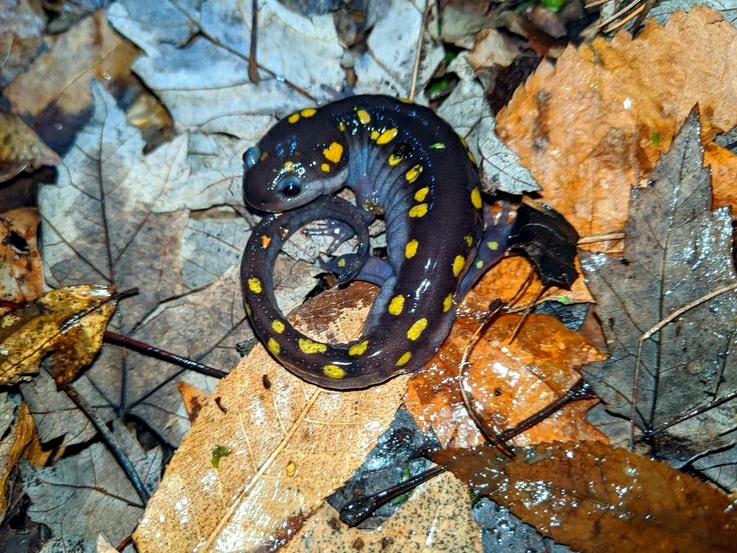Spotted Salamanders, also called yellow-spotted salamanders, are secretive amphibians found throughout much of the eastern United States and Canada. These salamanders are occasionally sold as pets but are somewhat rare because they are protected in large portions of their natural range.
Like many amphibians, Spotted salamanders produce poisonous skin secretions that make them taste bad to predators. These secretions are merely irritating and won’t kill a human, even if ingested. However, they can make some small animals sick.
Spotted salamanders are normally very harmless creatures, provided they are handled carefully. The only real threat they have is that they and other amphibians can carry Salmonella which is harmful to humans, so it’s best not to touch them.
If you do handle one, practicing sufficient levels of hygiene and washing your hands after, should keep you out of harm’s way.
Spotted Salamanders Only Secrete a Mild Toxin
The secretion may also have the added benefit of making the salamander slightly slimy, making it harder for predators to get a firm grip. While the predator is still trying to get a grip, the salamander can dash to safety.
Bright Yellow Spots Warn Predators of the Spotted Salamanders’ Toxic Defense
If you see a brightly colored amphibian, those colors usually mean “stay away from me, I’m toxic!” (think poison dart frogs).
Such coloration is called aposematism or ‘warning coloration. Many animals use it to advertise that they are toxic and would make a horrible meal for any would-be predator.

In the case of spotted salamanders; the distinctive vivid yellow to orange spots speckled along their black backs, tell predators that these salamanders have a toxin and would make a horrible meal.
An animal that eats a brightly colored spotted salamander will get a mouthful of toxin and remember the experience. The next time that animal sees another similarly colored salamander, it will associate those colors with danger and learn to avoid it.
Poisonous but Not Venomous
People often use the words “poisonous” and “venomous” interchangeably, but you should know that these two terms mean very different things.
Sure, they both refer to toxins that can be harmful to us, but the difference lies in how the toxins are delivered.
Generally;
- Venomous animals will bite, sting, or stab you to deliver their toxin.
- On the other hand, you have to eat or touch poisonous animals to be affected by their toxin.
This means venomous animals need a way to inject their toxins, such as fangs or stings. Poisonous animals on the other hand are more passive, often lining their skin with toxins to deter predators.
 In this way, bees are venomous, along with plenty of snakes, spiders, and scorpions while many frogs, newts, and Salamanders, including spotted salamanders, are poisonous.
In this way, bees are venomous, along with plenty of snakes, spiders, and scorpions while many frogs, newts, and Salamanders, including spotted salamanders, are poisonous.
Spotted Salamanders Typically Aren’t Dangerous to Humans
This can happen when you handle a spotted salamander with your bare hands, then rub your eyes without first washing your hands.
Ingesting toxins this way would most likely give you a painful sting, similar to the feeling you get when chili gets in your eye. It may even cause inflammation in the mucous membranes of your eyes.
Another way the toxins can be absorbed is through open sores or cuts on your skin. This would most likely lead to a burning sensation and a feeling of numbness at the point of contact.
For this reason, it is a good idea to avoid handling spotted salamanders, or any other salamanders. Although their poison is not lethal when ingested by humans, it can still be very irritating.
If you ever need to handle a spotted salamander, remember to avoid touching your eyes, nose, or mouth until you have washed your hands. Also, avoid handling salamanders with your bare hands if you have open cuts or scratches on your hands.
Salamanders Can Carry Salmonella
Like most amphibians, spotted salamanders can carry harmful bacteria called salmonella in their digestive tracts.
A salamander carrying salmonella may look very clean and healthy but can transmit the bacteria to humans. Humans can be exposed through contact with the salamander or its droppings.

You can also be exposed by touching anything the salamander has come In contact with, such as water in an aquarium/terrarium where the salamander lives.
Exposure to salmonella can cause an infection called salmonellosis, which is characterized by a running stomach, fever, and sometimes even vomiting.
The infection is usually mild but can spread to the bloodstream, leading to severe and sometimes even fatal illness.
Fortunately, you won’t get sick by simply touching a spotted salamander. The bacteria can only cause illness when they get inside your body.
For this reason, it is important to practice good hygiene and wash your hands with antibacterial soap after touching salamanders or anything they came in contact with.
Are Spotted Salamanders Dangerous to Dogs, Cats, or Other Pets?
If a pet, for instance, a dog or cat were to bite or attack a spotted salamander, it would get a mouthful of bitter toxin and most likely let go right away.
If a dog (or cat) ingests enough of this secretion, it may droll, foam at the mouth, and in some cases even vomit. Although only mildly poisonous, the secretion is still strong enough seriously irritate a dog (especially small dogs) or cat.
Fortunately, there are no documented deaths or serious injuries of pets that have attacked or tried to eat a spotted salamander.
Still, it’s best to keep your dogs, cats, or any other pets away from spotted salamanders (and any other salamanders) if you can. If you have pet salamanders at home, keep them secured in their enclosure so they do not come in contact with any of your other pets.
Salamanders Can Carry Parasites
In addition, salamanders often carry tapeworms and other parasites, so a dog that eats a spotted salamander is not only at risk of poisoning, but may also be exposed to parasites.
Also, as earlier mentioned, salamanders can carry salmonella bacteria so a dog or cat that mouths, bites or eats a spotted salamander may ingest the bacteria and develop an infection.
Safety Precautions to Take When Handling Spotted Salamanders
In general, It’s not a good idea to handle spotted salamanders. This is because they have very delicate semi-permeable skin which they use to absorb moisture and oxygen.
Their skin does not just absorb water though, anything that comes in contact with their skin can be absorbed, including salts, lotions, and other chemicals on your hands.
This means handling a spotted salamander with dirty hands can harm it. Substances on your hands can be absorbed into the salamander’s body. For this reason, it is a good idea to never handle salamanders unless you absolutely have to.
If you ever have to handle a salamander, take the following safety precautions:
Before Handling
- Very thoroughly wash your hands and ensure they are very clean. Not just clean from dirt, but washed off thoroughly so that there is no residue of soap or any other potentially harmful substances that remain.
How to Safely Handle
- Gently pick up the salamander and allow it to walk on your hands without restraining it. The salamander will just sit, or walk across your hands.
- Do not put any force or stress on the salamander because if you do, it will feel threatened and secrete its toxin all over your hands.
- Keep the salamander away from your eyes nose and mouth and, be very careful not to touch your face.
- Very gently put the salamander down. If you found the salamander on your property (or on the road), move it to the closest forested area preferably near a stream or another body of water. The salamander will find its way from there.
Salamanders should only be handled for a short time. Handling a salamander for too long can stress the animal or even dry out and damage its skin.
After Handling
- Very thoroughly wash your hands with anti-bacterial soap.
Remember, salamanders can secrete toxins and may carry salmonella so you have to protect yourself. Even if you wore gloves, I suggest you go the extra mile and wash thoroughly.
Before washing your hands, do not touch your face, rub your eyes, or put anything in your mouth.
Frequently Asked Questions:
Question: Do spotted salamanders bite?
Answer: Spotted salamanders do bite, however, this is very rare. They are normally very docile creatures that will typically put up no fight in your hands aside from an initial struggle.
The only time a spotted salamander may bite is during feeding when it mistakes your finger for food, or when it is being handled in a way that makes it uncomfortable.
A bite from a spotted salamander is nothing to be worried about. It’s more of a shock than anything because its tiny teeth are unlikely to even hurt your skin.
For more thorough information, check out this post I wrote on this topic.
Conclusion
Spotted salamanders are normally harmless creatures when left alone. The only real threat they pose is that they can be carriers of salmonella, which can be transmitted to humans.
However, this threat can be dramatically reduced by simply practicing decent levels of hygiene. Other than that, spotted salamanders are mostly harmless creatures.
Photo credit: adamgabriel/inaturalist. yan_tonz/inaturalist.


